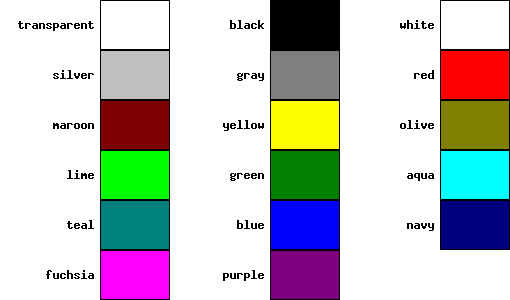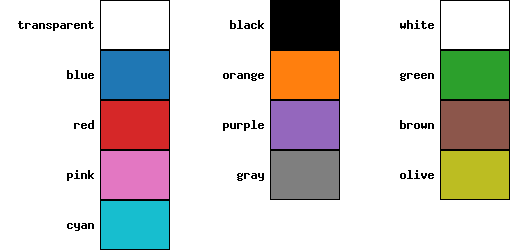Working with Color¶
8-bit color¶
py_gd works with colors in (RGB) space. But an interface is provided to work with colors by name. With 8-bit color (The only option in the current version), up to 255 colors can be used.
Before a new color can be used, it needs to be added to the image’s “palette” (mapping between integer value and RGB color). Colors cannot be removed from the palette once added.
Transparency:¶
py_gd support RGBA colors for transparency. Many of the default colorschemes have a transparent background by default.
Note
Some backends do not support transparency backgrounds – BMP, GIF, JPEG. PNG is a good option if you want a transparent background.
If you draw with a semi-transparent color, the blending will be done directly when drawing.
colorschemes¶
By default, an Image is created with the “web” colorscheme, so you have access to the standard html colors by name. You can see what colors are available in the current Image by calling the get_color_names method:
In [6]: img.get_color_names()
Out[6]:
['transparent',
'black',
'white',
'silver',
'gray',
'red',
'maroon',
'yellow',
'olive',
'lime',
'green',
'aqua',
'teal',
'blue',
'navy',
'fuchsia',
'purple']
Image.get_colors will return the names and associated RGB values:
img.get_colors()
Out[2]:
{'transparent': (0, 0, 0, 127),
'white': (255, 255, 255),
'black': (0, 0, 0),
'red': (229, 0, 0),
'blue': (3, 67, 223),
'green': (21, 176, 26),
'purple': (126, 30, 156),
'pink': (255, 129, 192),
'brown': (101, 55, 0),
Note that the first color in the list is the background color.
Other colorschemes are available for initialization – py_gd.colors.colorscheme_names will show them all:
py_gd.colors.colorscheme_names
Out[6]:
[('transparent', 'discrete'),
('BW', 'discrete'),
('web', 'discrete'),
('tableau', 'discrete'),
('css4', 'discrete'),
('xkcd', 'discrete'),
('cividis', 'continuous'),
('inferno', 'continuous'),
('magma', 'continuous'),
('plasma', 'continuous'),
('turbo', 'continuous'),
('twilight', 'continuous'),
('viridis', 'continuous')]
The “discrete” colorshemes are a set of colors that are specific colors designed to contrast with one another. The “continuous” colorshemes are a smoothly varying range of colors – good for use with “heat maps” or the built in ColorRamp system.
In order to use a different color, it needs to be added to the image’s color pallet first. Colors can be added to the image by providing a name and an RGB triple (or RGBA quad for alpha:
img.add_color('grey', (100, 100, 100))
After adding the color, it can be used by name:
img.draw_rectangle((10, 20), (60, 70), color = 'grey')
Color Ramps:¶
A color ramp (also called a color gradient) is continuous color scheme that maps a color to a value. They can be used to draw a “heat map”, or other image where the color is a function of some value.
To work with a color ramp, you need to have a continuous set of colors to pick from, and a way to map a value to particular color. The ColorRamp class provided a way to make all this easy.
Using a ColorRamp¶
A color ramp requires the following information to be useful:
- Colors:
What colors to use – this needs to be a sequence of RGB colors that form a continuum of some sort.
py_gdprovides a set of color ramps borrowed from the Matplotlib package – these have been carefully designed by the MPL folks.- Range of values:
in order to map a color to a value, you need to specify what the highest and lowest values that you want to consider are. These are specified by the
min_valueandmax_valueparameters – the first color will be mapped to themin_value, and the last color will be mapped to themax_value, with value in between linearly interpolated to the closest color.
- ::
cr = ColorRamp(‘inferno’, 100, 1000, num_colors=250)
The Trick of 8-bit Color¶
py_gd (currently) only support 8-bit color, which means there can be only 256 total colors in a given image. This works fine for the most part: 256 colors is enough to create about as much distinction as a person can see (particularly on a computer screen). However, in a given image, you may want the color ramp, but also a few other colors, such as black and white, etc. that can be used to draw other things in the image, so you need a color ramp that can use an arbitrary number of colors.
To accommodate this, the ColorRamp class allows you to set the number of colors you want to use for the ramp, either explicitly by setting num_colors parameter, or specifying the color scheme currently used (or specifying how many colors have been reserved already).
Once a ColorRamp has been defined, you can get the color indexes corresponding to given values with the get_colors_indices() method, and the full set of colors used with the colorlist property.
For an example of using a ColorRamp, see: Using a ColorRamp
Builtin ColorSchemes:¶
The following are the built-in colorschemes.
BW:

web:

tableau:

css4:

xkcd:

cividis:

inferno:

magma:

plasma:

turbo:

twilight:

viridis:
